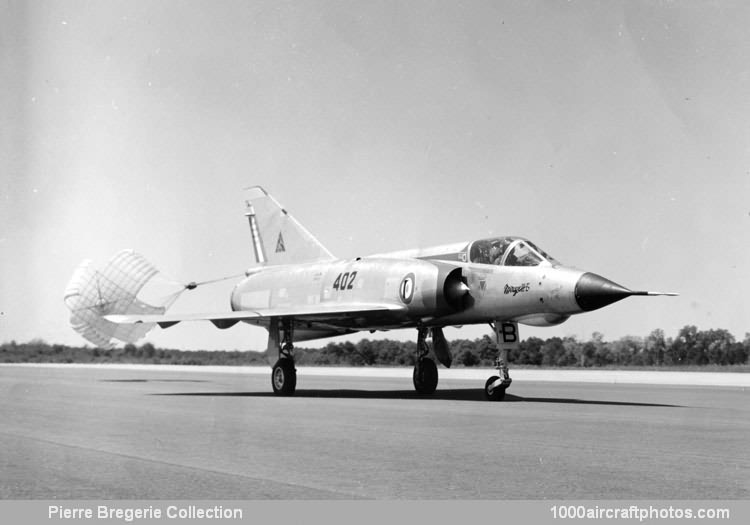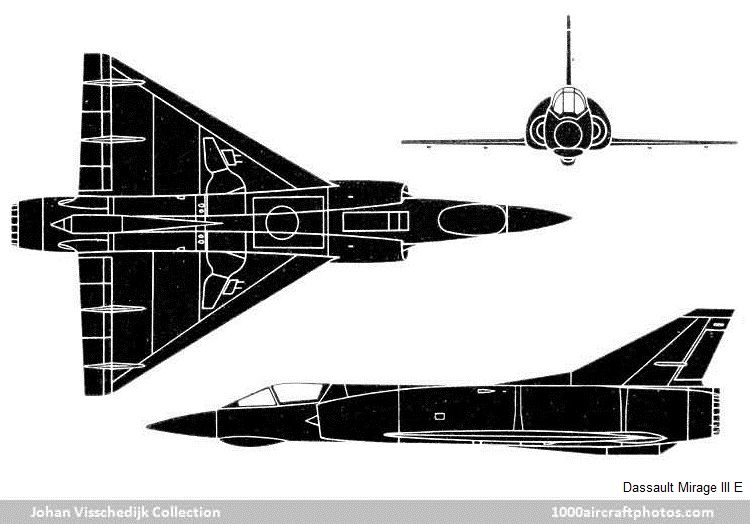The airframe differed essentially from that of the Mirage III C in having an 11.8 in (0.30 m) extension of the forward fuselage to permit enlargement of the avionics bay behind the cockpit. Dual-role radar was introduced and the Atar 09C-3 engine was adopted, this providing an afterburning thrust of 13,668 lb (6,200 kg) and being augmented by the 3,307 lb (1,500 kg) thrust of a SEPR 841 rocket motor.
The first production Mirage III E was delivered on January 14, 1964, and a total of 192 was subsequently delivered to France's Armée de l'Air. Built-in armament comprised two 1.18 in (30 mm) cannon and maximum external ordnance load (distributed between five hardpoints) was 8,818 lb (4,400 kg).
Versions were license-built in Australia and Switzerland as the Mirage III O and III S respectively. Differences between the Mirage III E and III O were largely confined to avionics, and two versions were delivered to the RAAF, the Mirage III O(F) primarily for the intercept role, and the Mirage III O(A) for the attack task.
Dassault supplied two pattern Mirage III O(F) aircraft, the first of which flew on March 14, 1963, and 48 Mirage III O(F) and fifty Mirage III O(A) were built for the RAAF by the Government Aircraft Factory and Commonwealth Aircraft. All Mirage III O(F) aircraft were converted to III O(A) configuration during 1967-1979 and the latter were finally withdrawn from service in 1988, the 50 surviving examples being procured by Pakistan in 1990.
After acquiring a single Mirage III C for trials, Switzerland built 36 Mirage III S interceptors (plus 18 Mirage III RS reconnaissance aircraft), these entering service in 1966 with the Flugwaffe, and, in the early 1990s, the 30 surviving Mirage III S fighters were being rotated through an upgrade program (including the provision of canards) at Emmen.
Exports by the parent company were as follows: Argentina (17 Mirage III EAs), Brazil (20 Mirage III EBRs), Lebanon (10 Mirage IIIELs), Pakistan (18 Mirage III EPs), South Africa (17 Mirage III EZs) , Spain (24 Mirage III EEs) and Venezuela (10 Mirage III EVs). The Brazilian Mirage III EBRs, ordered in 1970, were upgraded with canards, pressure refueling, etc, from 1989, and the total quoted includes four ex-Armée de l'Air delivered in 1988 in the upgraded configuration. The South African Mirage III EZs were rebuilt to Cheetah EZ standard by Atlas Aircraft.
In 1989, Dassault Aviation offered an upgrade of ex-Armée de l'Air aircraft as the Mirage III EX, this having canards, flight refueling capability and a lengthened nose.
The pictured aircraft was used by the C.E.A.M. (Centre d'Expériences Aériennes Militaires, military flight test center). Subsequently the aircraft served with several squadrons, by July 1996 it was stored at the Musee du Chateau, Savigny les Beaune, France, although in an uncomplete/damaged status."
The following data relate to the Mirage III E.

